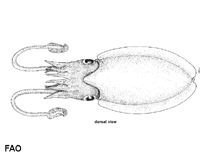Rhombosepion elegans (Blainville, 1827)
Elegant cuttlefish
Классификация / Names народные названия | синонимы | CoL | ITIS | WoRMS
Cephalopoda | Sepiida | Sepiidae
Environment: milieu / climate zone / пределы глубины / distribution range экология
; солоноватоводный; пределы глубины 16 - 500 m (ссылка 1695), usually 150 - 150 m (ссылка 1695). Tropical; 60°N - 15°S, 21°W - 37°E (ссылка 1695)
Distribution страны | регионы FAO | Ecosystems | места находок | интродукции
Eastern Atlantic and the Mediterranean: from UK to Angola.
Length at first maturity / Size / Weight / Возраст
половая зрелость: Lm ? range ? - ? cm Max length : 7.2 cm ML самец/пол неопределен; (ссылка 1695); 8.9 cm ML (female); наибольший вес (опубликованные данные): 60.00 g (ссылка 1695)
Minimum depth range from Ref. 114857. Demersal (Ref. 1970). Sublittoral; most abundant at about 150 m depth, with sporadic records below 450 m (Ref. 1695). Found in the continental shelf and upper slope (Ref. 1970). Found in brackish waters of the Sea of Marmara, indicating its high degree of tolerance. Spends winter in deep waters between 200 to 400 m and migrates into shallow waters to spawn in spring and summer; optimally at water temperatures between 13° to 18°C (Ref. 1695). In the Gulf of Guinea, off west Africa, spawns in shallow inshore waters throughout the year (Refs. 417, 1695). Juveniles are found in an estuary (Ref. 122954). In the Mediterranean Sea, perennial presence of mature males and females suggest a continuous spawning period. Eggs (5 mm diameter) are laid in clusters of 12 to 25, on muddy substrates, attached to alcyonarians (sea fans), shells, etc. Hatched juveniles immediately assume a benthic lifestyle. Maturity at 1 year of age. Lifespan is at 12 to 18 months. Taken mainly as bycatch in the Mediterranean and west African trawl fisheries; a valuable local resource in the Mediterranean. Intensely fished in the Sicilian Channel. Marketed fresh and frozen (Ref. 1695).
Life cycle and mating behavior половая зрелость | размножение | нерест | Eggs | Fecundity | Larvae
Members of the class Cephalopoda are gonochoric. Male and female adults usually die shortly after spawning and brooding, respectively. Mating behavior: Males perform various displays to attract potential females for copulation. During copulation, male grasp the female and inserts the hectocotylus into the female's mantle cavity where fertilization usually occurs. Life cycle: Embryos hatch into planktonic stage and live for some time before they grow larger and take up a benthic existence as adults.
Основная ссылка
ссылки | координатор | соавторы
Jereb, P. and C.F.E. Roper (eds.). 2005. (ссылка 1695)
Статус Красного Списка МСОП
(ссылка 130435: Version 2024-2)
Нехватка данных (DD) ; Date assessed: 13 March 2009
Статус СИТЕС (ссылка 108899)
Not Evaluated
CMS (ссылка 116361)
Not Evaluated
Угроза для людей
Использование человеком
рыболовство: коммерческий
| FishSource |
инструменты
дополнительная информация
Trophic Ecology
экология
Population dynamics
рост
Max. ages / sizes
Length-weight rel.
Length-length rel.
Размерный состав
Mass conversion
пополнение
численность
Max. ages / sizes
Length-weight rel.
Length-length rel.
Размерный состав
Mass conversion
пополнение
численность
Life cycle
Distribution
Human Related
Aquaculture profiles
Stamps, coins, misc.
Stamps, coins, misc.
Outreach
Taxonomy
ссылки
ресурсы в Интернет
BHL | BOLD Systems | CISTI | DiscoverLife | FAO(Publication : search) | Fishipedia | GenBank (Геном, Нуклеотид) | GloBI | Gomexsi | Google Books | Google Scholar | Google | PubMed | Tree of Life | Wikipedia (Вперёд, поиск) | Zoological Record



